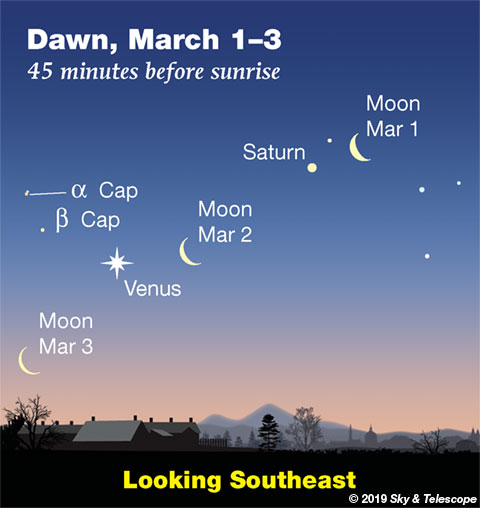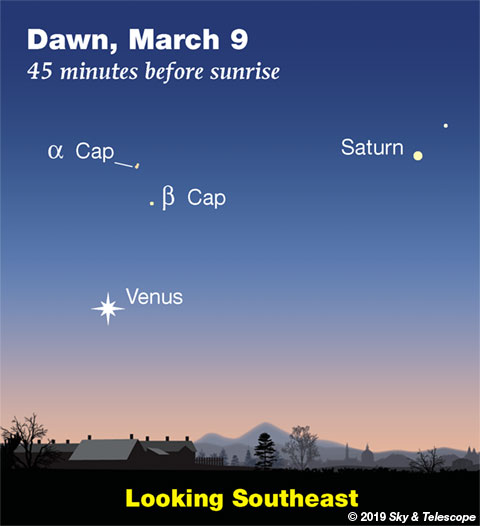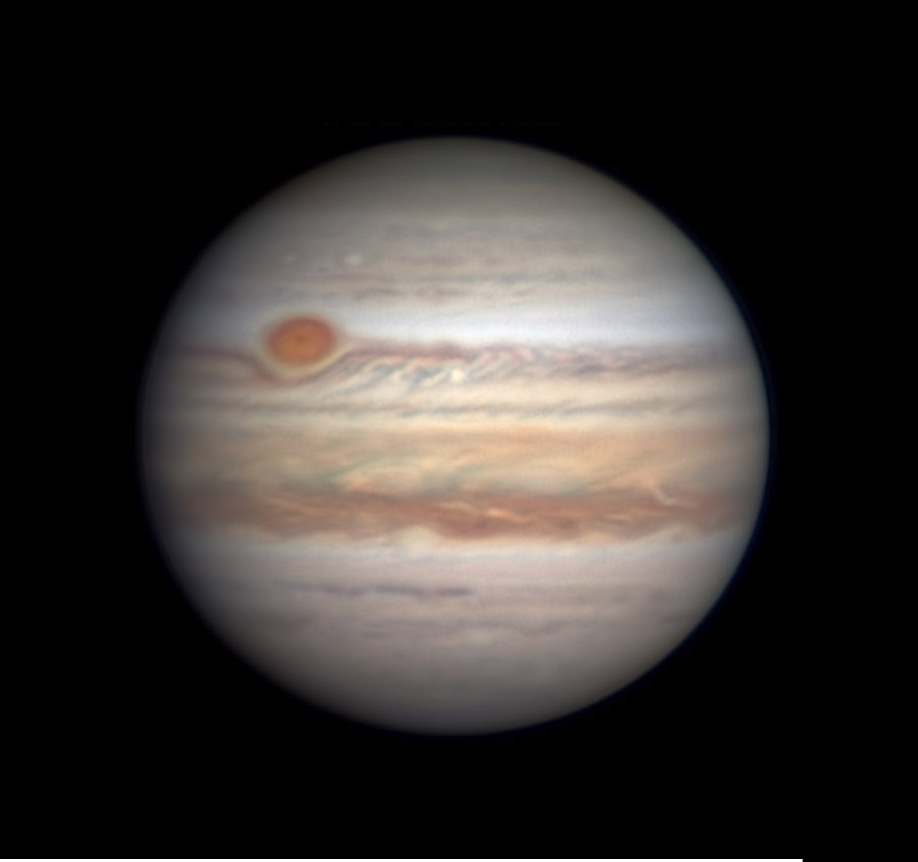Friday, March 1
• Distant little Mars still glimmers high in the west at nightfall, in Aries.
This evening it's directly between Mars-colored Alpha Arietis (Hamal) 10° to its right (a fist at arm's length), and Mars-colored Alpha Ceti (Menkar) a little farther to the planet's left. The two stars are not all that much fainter than Mars is now.
• This is the time of year when Orion stands straight upright due south as the stars come out, with his belt diagonal. Later in the evening, and later in the month, Orion begins his long tilt down to the southwest.


• Algol is at its minimum light, magnitude 3.4 instead of its usual 2.1, for about two hours centered on 7:19 p.m. EST. When you glance up at Algol at a random time, you have only a 1 in 30 chance of catching it at least a magnitude fainter than normal.
• In Saturday's dawn, the waning crescent Moon hangs very low with Venus, as shown at right.
Saturday, March 2
• Look east after dusk this week for Leo already climbing well up the sky. Its brightest star is Regulus. The Sickle of Leo, about fist and a half tall, extends upper left from there. "Leo announces spring," goes the poetic old saying, but really, what Leo announces is the sloppy back end of winter.
Sunday, March 3
• Sirius stands due south right around the end of twilight. It's not only the brightest star in the sky after the Sun, it's also the closest naked-eye star after the Sun, at 8.6 light-years, for those of us at mid-northern latitudes. Alpha Centauri is the actual closest star at 4.36 light-years, but you have be be farther south to see it. And in the northern sky three dim red dwarfs are closer than Sirius, but these require binoculars or a telescope.
Monday, March 4
• Since it's early March now, quite soon after dark the Big Dipper rises as high in the northeast as Cassiopeia has descended to in the northwest. Midway between them, as always, is Polaris.
Tuesday, March 5
• More about Sirius and Canis Major. In a very dark sky the Big Dog's realistic stick figure is plain to see — the dog is in profile prancing to the right on his hind legs, with Sirius as his shiny dog tag — but for most of us only his five brightest stars show through. These form the unmistakable Meat Cleaver. Sirius and Murzim (to its right) are the wide front end of the cleaver, with Sirius sparkling on its top back corner. Down to Sirius's lower left is the Cleaver's other end, including its short handle, formed by the triangle of Adhara, Wezen, and Aludra.
Wednesday, March 6
• After dark, Capella shines brightly high in the northwest. Between it and Polaris, 43° to its lower right due north, is a very dull region of sky — in fact blank for those of us with significant light pollution. This is the enormous celestial terrain of Camelopardalis, the Giraffe. Even if you can't see any of its rather indecipherable star pattern, now you know the whereabouts of another constellation.
• New Moon (exact at 11:04 a.m. EST).
Thursday, March 7
• Betcha don't know about the yellow-eyed flying bat in Leo Minor near Lynx. Its wingspan extends nearly across your binocular field of view. Discover this asterism upper right of Leo's Sickle these evenings with Matt Wedel's Binocular Highlight column and chart in the March Sky & Telescope, page 43. As he notes there, "It only flies right-side up when Pollux and Procyon are crossing the meridian," as they are now.
Friday, March 8
• It's not spring for another couple weeks, but the Spring Star Arcturus seems eager to thrust itself into view. It rises above the east-northeast horizon soon after dusk now depending on your latitude.
To see where to watch for this, find the Big Dipper as soon as the stars come out; it's high in the northeast. Follow the curve of its handle down and around to the lower right by a little more than a Dipper-length. That's the spot on the horizon to watch.
Saturday, March 9
• By full dark, the Big Dipper is high in the northeast and beginning to tip left. Look well to its left for Polaris and the dim Little Dipper. Other than Polaris, all you may see of the Little Dipper through light pollution are the two stars forming the outer edge of its bowl: Kochab (similar to Polaris in brightness) and below it, fainter Pherkad. Find these two "Guardians of the Pole" to Polaris's lower right by about a fist and a half at arm's length.
Now is the time of year when the Guardians line up exactly vertically at the end of twilight.
• At 2 a.m. tonight, daylight-saving time begins for most of the US and Canada. Clocks "spring ahead" an hour.
________________________
Want to become a better astronomer? Learn your way around the constellations. They're the key to locating everything fainter and deeper to hunt with binoculars or a telescope.
This is an outdoor nature hobby. For an easy-to-use constellation guide covering the whole evening sky, use the big monthly map in the center of each issue of Sky & Telescope, the essential guide to astronomy.

Once you get a telescope, to put it to good use you'll need a detailed, large-scale sky atlas (set of charts). The basic standard is the Pocket Sky Atlas (in either the original or Jumbo Edition), which shows stars to magnitude 7.6.
Next up is the larger and deeper Sky Atlas 2000.0, plotting stars to magnitude 8.5; nearly three times as many. The next up, once you know your way around, are the even larger Interstellarum atlas (stars to magnitude 9.5) and Uranometria 2000.0 (stars to magnitude 9.75). And read how to use sky charts with a telescope.
You'll also want a good deep-sky guidebook, such as Sue French's Deep-Sky Wonders collection (which includes its own charts), Sky Atlas 2000.0 Companion by Strong and Sinnott, or the bigger Night Sky Observer's Guide by Kepple and Sanner.
Can a computerized telescope replace charts? Not for beginners, I don't think, and not on mounts and tripods that are less than top-quality mechanically (meaning heavy and expensive). And as Terence Dickinson and Alan Dyer say in their Backyard Astronomer's Guide, "A full appreciation of the universe cannot come without developing the skills to find things in the sky and understanding how the sky works. This knowledge comes only by spending time under the stars with star maps in hand."
Mercury descends this week in evening twilight while also fading rapidly from magnitude 0.0 to 2.0. Look for it low in the west in mid-twilight, the earlier in the week the better. On what date can you last detect it? Bring binoculars!
Venus (magnitude –4.1) rises above the east-southeast horizon shortly before the first light of dawn. By 30 minutes to sunrise it's up about 13° depending on your latitude.
Mars (magnitude +1.2, in Aries) still glows high in the west at nightfall and sets around 11 p.m. In a telescope it's a tiny blob 5 arcseconds wide, and it won't get any better all year.

Jupiter (magnitude –2.0, in the feet of Ophiuchus) rises in the southeast in the early-morning hours and shines low in the south-southeast by very early dawn — the best time to examine it with a telescope.
Antares and the head of Scorpius sparkle to Jupiter's right at that time. Have a look in on Beta Scorpii, a fine telescopic double star. It's the top star of the upright row of three marking Scorpius's head to the right of Antares.
Saturn (magnitude +0.6, in Sagittarius) glows between the more overpowering Jupiter and Venus in early dawn.
Uranus (magnitude 5.8, at the Aries-Pisces border) is sinking low in the west far below Mars.
Neptune is hidden in conjunction with the Sun.
Damian Peach made this full-rotation composite of Jupiter from images he took last May around the time of Jupiter's opposition, using a 14-inch Schmidt-Cassegrain telescope on Barbados. In software, he mapped the images onto a virtual globe with Jupiter's slightly ellipsoidal shape. North is up.
______________________
All descriptions that relate to your horizon — including the words up, down, right, and left — are written for the world's mid-northern latitudes. Descriptions that also depend on longitude (mainly Moon positions) are for North America.
Eastern Standard Time (EST) is Universal Time (UT or GMT) minus 5 hours.
______________________
Audio sky tour. Out under the evening sky with your earbuds in place, listen to Kelly Beatty's monthly podcast tour of the heavens above. It's free.
______________________
"Science is built up of facts, as a house is with stones. But a collection of facts is no more a science than a heap of stones is a house."
— Henri Poincaré (1854–1912)
______________________
 5
5








Comments
mary beth
March 3, 2019 at 6:37 pm
Rod - hope all is clear and bright there. We might clear off tomorrow night!! I’ll keep you posted! Look I go forward to crescent moon later this week.
You must be logged in to post a comment.
Rod
March 4, 2019 at 7:53 am
mary beth said "Rod – hope all is clear and bright there." mary beth - no it is not 🙂 For a number of days now in Maryland, periods of snow/ice pellets, rain, clouds. Today we may be starting a few days of clear skies at night (mostly clear - ha, I have seen this forecast before) with temps near 20F. I will wait and see if I can view using my telescopes. There are some galaxies in Leo I want to look at and other targets-but need the clouds to depart the region 🙂 Enjoy some clear skies for your stargazing.
You must be logged in to post a comment.
Rod
March 5, 2019 at 7:55 am
mary beth, yes clear skies and temps 27F here last night when I viewed from 10:00 PM until 11:30 PM. I enjoyed using my 10-inch telescope (dob mount) with 35-mm, 2-inch eyepiece for low power wide field views (35x) and the 14-mm, 1.25 inch eyepiece for views 86x. Excellent viewing in Leo last night. I enjoyed galaxies M65, M66, NGC 3628 in the same field of view. NGC 3628 is very elongated shape in the 10-inch compared to my 90-mm refractor and much brighter image. I see brighter galaxies and more area of the galaxies using the 10-inch telescope, the galaxies can take higher power views. M95 and M96 were nice and bright, I viewed at 35x. This is 1.8 degree true field of view. The 86x view is a bit more than 0.8 degrees. I did some unaided eye viewing of stars testing limiting magnitude. About +5.6 or so - not the best but good. I was out on my backyard sidewalk using a small step ladder for sitting while using the dob mounted 10-inch reflector. Very comfortable views and easy sitting 🙂
You must be logged in to post a comment.
Rod
March 6, 2019 at 8:54 pm
Did mary beth do some stargazing? I was out this evening from 7:00 PM to 8:00 PM EST. Clear skies and temps -4C. Enjoyed some good telescope views of open clusters in Monoceros and Puppis, e.g. M50, M47. On Saturday, 02-Feb-19, I watched Punxsutawney Phil, the groundhog come out live on TV early that morning near 7:00 AM. That groundhog did not have his game face on and has lost his edge 🙂 We are still enjoying winter in Maryland, tonight temps -7C or so. Wood burning stove sure feels good 🙂
You must be logged in to post a comment.
mary beth
March 8, 2019 at 12:36 am
Oh I bet that stove is wonderful! We are actually quite warm here right now but it’s raining unfortunately. The news reported that we have had the cloudiest winter in over 60 years! We might have one clear day before the rain starts up again next week. It’s really unbelievable and quite depressing, and I am an optimist LOL. I’m glad you’re having clear skies and enjoying the spring stars! Guess we’ll have a pretty tiny crescent moon tomorrow night let me know if you see it! You’re probably comment on next weeks because they’ll be posting that in a few hours!
You must be logged in to post a comment.
You must be logged in to post a comment.